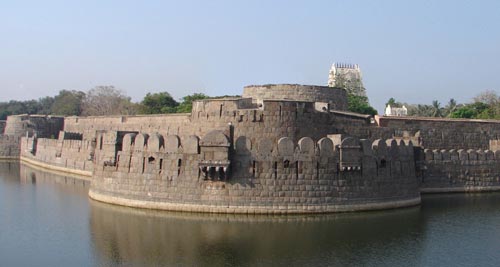Vellore Fort

Information on Vellore Fort (Vellore, Tamil Nadu) - History & Architecture
The Vellore Fort is one of the largest forts positioned in Vellore city, Tamil Nadu. The fort was primarily built during the reign of the Vijayanagara Kings. At one point the fort served as the headquarters of the kings during the Vijayanagara rule. The place is popular mainly form is grand artefacts and stonework. Inside the fort one can find Christian church, the Muslim mosque and more of all Hindu temple, all religious temples making it even more unique and important from both historical as well as cultural point of view.
Vellore Fort Architecture
It must be mentioned that there is no such monument in earth like that of the Vellore owing to its architectural significance. The fort has a channel where it is believed that thousands of crocodiles swarmed once. The walls of the fort have double walls which were intended to protect it from enemy. The structure was mainly built with granite acquired from the Arcot and Chittor regions. The entire fort is situated is over an area of around 133 acres at a height of 220 of the nearest mountain range. The fort also has an escape channel of 12 km long that directly connects to Virinjipuram. It was used by the kings resided in the fort at the time of attack. It is one of the better places in India in terms of its military architecture. There are houses, temples, mosques as well as churches within the fort that are still being used in the present day scenario. All of these parts of the fort have the work of skilled artisans of that period. The sculptures and portraits within the fort also depict the masterpiece of its art and architecture.
Vellore Fort History
The fort has a rich heritage associated with it. The Vellore Fort was constructed by the duo of Chinna Bommi Reddy and Thimma Reddy during the reign of Sadasiva Raya in 1566 AD. The Fort acquired tactical fame after restoration of the Vijayanagar rule post Talikota battle. The Rayas i.e. people of the Aravidu Dynasty used the fort as a residence in the 17th century. It was also served as a base camp during the Toppur battle in 1620s. The fort also witnessed the battle of the Raya family. The subordinates of the king of the Aravidu Dynasty such as the Nayaks of Tanjore and Gingee were interested in acquiring control over the fort. During 1650s, the sultans of Bijapur send off a huge army to Vellore and succeeded in capturing the Fort. The defeat of the Vellore during this period marked the end of the Vijayanagara emperors and their rule over the city and the fort. 20 years post that period the fort was further seized by the Marathas through defeating the Sultans of Bijapur.
After that, again in the year 1676, Maharathas under the able leadership of Shivaji, marched towards South of the Tanjore Country recently captured by the Chokkanatha Nayak of Madurai and with immediate threat the fort was again captured by Shivaji's army in the year 1677. Rest leaving the task of attacking Vallore on this assistant, Shivaji proceed towards Deccan as his enemy Aurangabad was attacking his territories.
Vellore Fort Tourism Importance
With regard to the tourism sector, the fort presents a lot to look for the tourists in their stay in the place. The fort is open for tourists by the permission of the Archaeological Survey of India (ASI). It shows artefacts and ancient materials relevant to the subjects of geology, anthropology, botany and pre-history which will also attract the tourist. Furthermore, the fort is well conserved in each of its domain and thus visitors can witness a glimpse of others attractions of the fort such as mosque, church and the Jalakanteswara Temple within Vellore Fort quite conveniently and comprehensively.
- Andaman Nicobar Monuments
- Andhra Pradesh Monuments
- Assam Monuments
- Bihar Monuments
- Chhattisgarh Monuments
- New Delhi Monuments
- Goa Monuments
- Gujarat Monuments
- Haryana Monuments
- Himachal Pradesh Monuments
- Jammu and Kashmir Monuments
- Karnataka Monuments
- Kerala Monuments
- Madhya Pradesh Monuments
- Maharashtra Monuments
- Odisha Monuments
- Punjab Monuments
- Rajasthan Monuments
- Tamil Nadu Monuments
- Telangana Monuments
- Uttar Pradesh Monuments
- West Bengal Monuments